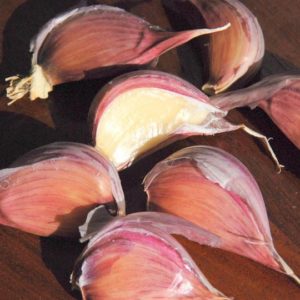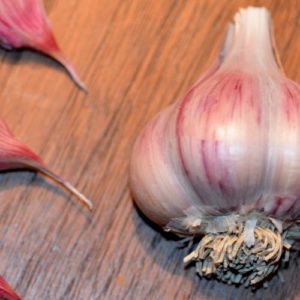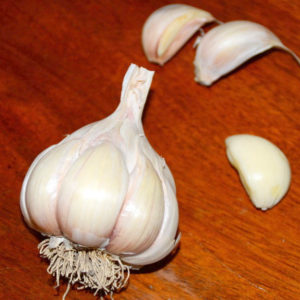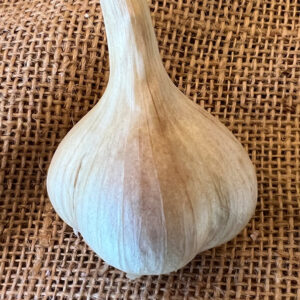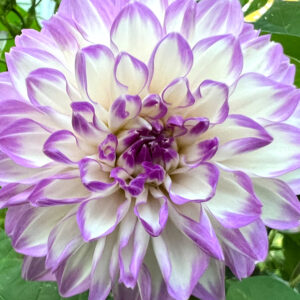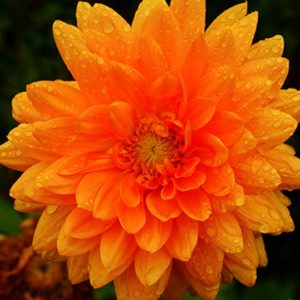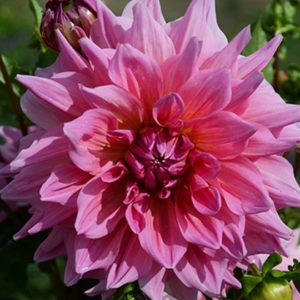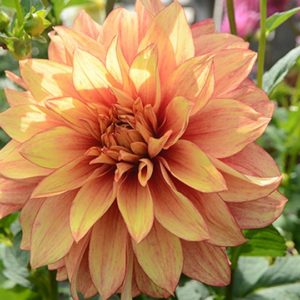Description
 Purple Striped Garlic, Persian Star
Purple Striped Garlic, Persian Star
GARLIC, which is a member of the same group of plants as the ONION, has been cultivated for millennia. As a cultivated plant, it is so old that it is difficult to credit a country of origin for this vegetable. Some historians believe that onions and garlic was indigenous to the southwest of Siberia and spread to southern Europe where it became naturalized. It is widely grown in all the Mediterranean countries.
All modern garlic belongs to one of two subspecies: hardneck (ophioscorodon) or softneck (sativum). Hardneck subspecies try to produce flower stalks with small aerial cloves called bulbils. Hardnecks will not produce large bulbs underground unless the flower stalks are removed. There are seven varieties of hardneck garlic: Asiatics, Purple Striped, Glazed Purple Stripe, Marbled Purple Stripe, Porcelain, Turban and Rocambole. Softnecks have lost the ability, for the most part, to produce a flower stalk. However, under certain climatic situations, the bulbs may try to produce a flower stalk known as bolting. There are four varieties of softneck garlic: Artichoke, Turban, Silverskin and Creole.
When people, who know even a little about garlic, think about the extraordinarily flavored garlics, they are usually thinking about the Purple Striped Garlics. In his exceptional treatise on garlic titled, The Complete Book of Garlic, Ted Jordan Meredith captures the essence and significance of the Purple Stripes in this brief paragraph:
“Genetically closest to the origins of the species, Purple Stripes are the ancestors and antecedents of all other garlic cultivars, and as the Fort Collins study (Volk et. al. 2004) showed, they are the basal group for all garlics. Purple Stripes are strongly bolting, hardneck cultivars. Some Purple Stripes, with assistance, remain capable of sexual reproduction and the production of seed. Not surprisingly, they also exhibit the greatest genetic diversity.”
The Striped Garlics, hardnecks, are so named because of the striking purple stripes and blotches on the clove skins and bulb wrappers. These are the most beautiful of all the garlic varieties and they also have outstanding flavor. Glazed Purple Striped varieties mature earlier than standard Striped varieties and are shinier. Both varieties have 8-12 cloves per bulb. Marbled Purple Stripe varieties have mottled bulb wrappers and large cloves, usually 4-7 cloves per bulb. One pound of the Glazed and Purple Striped varieties produce approximately 60 plants. One pound of Marbled Purple Stripe varieties produce approximately 50 plants.
Purple Stripes are so called because of the vivid purple striping of the bulb wrappers and the intense purple coloring of the clove wrappers. The Purple Striped cultivars available to us today originated, mostly, in The Republic of Georgia, Uzbekistan and Belarus.
Planting and Harvesting Garlic
Garlic is usually planted in October in the north and from November through January in the south. It is important to note that garlic should be planted 4-6 weeks before the ground freezes in order to establish good root growth before winter. If winters are long and temperatures are extreme, then softnecks should be planted in the spring.
Garlic bulbs planted in the fall go through a short, approximately 2-week dormant period, and then roots emerge and leaves sprout. With the onset of winter, the leaves die back and the roots cease to grow. This process is called vernalization. Proper bulbing is a function of adequate growth, vernalization and subsequent growth under longer days. Bulbs planted in the spring must experience some minimal cold treatment in order to insure proper bulbing.
Garlic can be grown in many different types of soil, but the plants prefer a rich moist sandy soil. Turn the soil and add some lime before planting. Break the bulbs apart into individual cloves and plant, root end down, two inches deep, with six inches between cloves in rows twelve inches apart. Mulch immediately. In the spring, apply a 10-10-10 fertilizer and water like any garden green. By summer ease up on the watering. The hardnecks will send up a flower stalk in early June. Approximately one week after the stalk begins to turn woody, starts to uncoil and begins to stand up straight, cut the stalk off ½ inch above the top plant leaf. This will redirect the plant’s energy into bulb production.
When harvest time is approaching, the plants will begin to dry from the bottom leaves up and from the leaf tips inward, one leaf at a time. The plants should be harvested when approximately 40% of the leaves are still green. Bundle in groups of 5-10 and hang inside, out of direct sunlight and where there is good air circulation. Never leave freshly dug bulbs in direct sunlight. The bulbs cure in 3-4 weeks. The bulbs are cured when the neck can be cut one-half inch above the bulb without any evidence of moisture.
Garlics are best stored in netted onion bags at room temperature. Temperatures of 34-44 degrees will induce sprouting. Temperatures in the 30’s are tolerable for table garlic, but planting stock should not be stored long at cold temperatures. Humidity in the 60%-70% is preferable. Rocamboles and Purple Stripes will store for approximately 6 months. Porcelains and Artichokes will store for approximately 8-10 months. Silverskins and Creoles will store for a full year.
Planting Garlic, Shallots, Onions and Elephant Garlic


